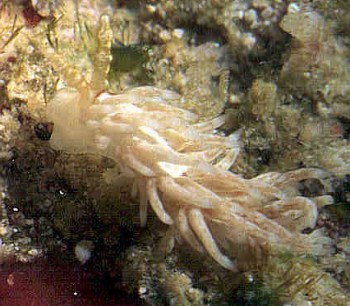
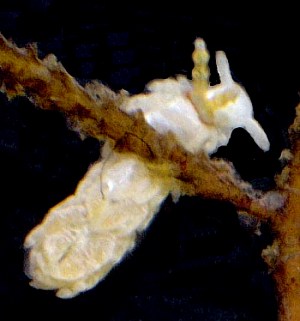
Aeolidiella alba
Risbec, 1928
Order: NUDIBRANCHIA
Suborder: AEOLIDINA
Family: Aeolidiidae
DISTRIBUTION
Tropical Indo-West Pacific. Records on the Forum from Pacific coast of Mexico and Florida suggest this species has a circum-global distribution in warm waters.
PHOTO
UPPER: Pulau Hoga, Tukang Besi Archipelago, SE Sulawesi, Indonesia. 5mm long, 3 August 1999, depth 19 ft. Photo: Lindsay Warren.
LOWER: North Reef (on sewer pipe), Dar es Salaam, Tanzania. May 1974. Photo: Bill Rudman.
This aeolid is characterised by the swellings on the rhinophores and the red line around their base. This line can form a complete ring around the rhinophores or in some case just a line on the posterior side. It has sometimes been called Spurilla alba but the characters defining the genera Spurilla and Aeolidiella are still under discussion. In radular morphology, this species matches other accepted species of Aeolidiella.
Reference:
• Risbec, J. (1928). Contribution à l'étude des nudibranches Néo-Calédoniens. Faune des Colonies Françaises, 2: 1-328.
Rudman, W.B., 2000 (July 19) Aeolidiella alba Risbec, 1928. [In] Sea Slug Forum. Australian Museum, Sydney. Available from http://www.seaslugforum.net/find/aeolalba
Related messages
Aeolidiella alba from sthn Queensland
January 16, 2009
From: Gary Cobb
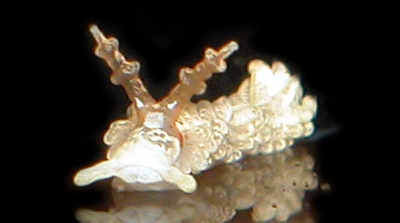
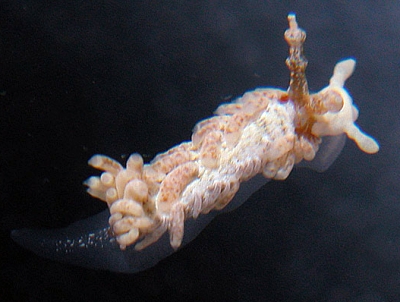
Concerning message #22086:
Hi Bill and everyone!
Here is a record of Aeolidiella alba from our area. We see this species quite a bit. I always stop to admire it's 'shuffle'. The only critter I know that has the same shuffle is Elysia verrucosa Jensen, 1985. I'll send you those photos later.
Locality: Old Woman Island, Mooloolaba, Sunshine Coast, 12m, Queensland, Australia, Pacific Ocean, 23 April 2004, Subtidal. Length: 18mm. Photographer: Gary Cobb.
Cheers
Gary Cobb
gary@nudibranch.com.au
Cobb, G.C., 2009 (Jan 16) Aeolidiella alba from sthn Queensland. [Message in] Sea Slug Forum. Australian Museum, Sydney. Available from http://www.seaslugforum.net/find/22100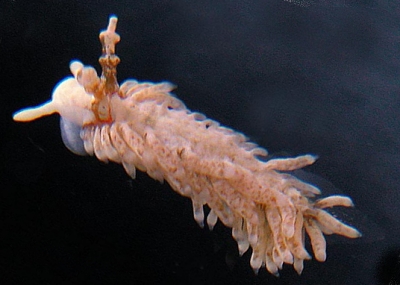
Thanks Gary,
Best wishes,
Bill Rudman
Re: Aeolidiella alba from Solomon Islands
December 15, 2008
From: Barbara Hanchard
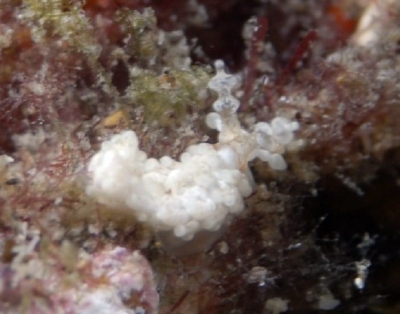
Concerning message #21952:
Bill,
My photo if it is of any use.
Locality: Leilei, 10 meters, Solomon Islands, Pacific, 10 August 2008, Sandy slope. Length: 1.5 mm. Photographer: N. Barbara Hanchard.
Barbara
barbara.hanchard@ffa.int
Hanchard, N.B., 2008 (Dec 15) Re: Aeolidiella alba from Solomon Islands. [Message in] Sea Slug Forum. Australian Museum, Sydney. Available from http://www.seaslugforum.net/find/22086Thanks Barbara,
Your photo shows the rhinophores very well. Not sure why your photo got lost on the first attempt
Best wishes,
Bill Rudman
Aeolidiella alba from Solomon Islands
October 16, 2008
From: Tamara Hartwich
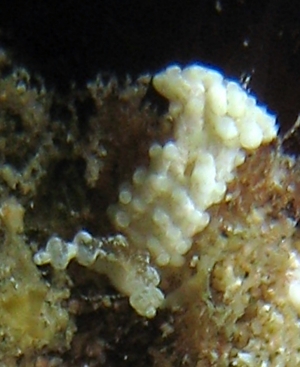
Concerning message #21583:
Dear Bill
I found the following nudibranch which we think is Aeolidiella alba in Solomon Islands and am sending it in for your records. I have attached two photos, the first was taken by Barbara Hanchard and the second by myself, both with difficulty given the small stature but energetic nature of this nudibranch.
Locality: LeiLei, 10 metres, Honiara, Solomon Islands, Pacific Ocean, 04 October 2008. Length: 2 mm. Photographer: Tamara Hartwich.
Regards
Tamara Hartwich
tamhartwich@yahoo.com.au
Hartwich, T.M., 2008 (Oct 16) Aeolidiella alba from Solomon Islands. [Message in] Sea Slug Forum. Australian Museum, Sydney. Available from http://www.seaslugforum.net/find/21952Dear Tamara,
I'm afraid only your photo arrived. I sympathise with the difficulty you had in photographing this animal. I seem to recall my efforts at photographing this species have been difficult.
Best wishes,
Bill Rudman
Aeolidiella alba from Reunion.
July 31, 2008
From: Hugues Flodrops

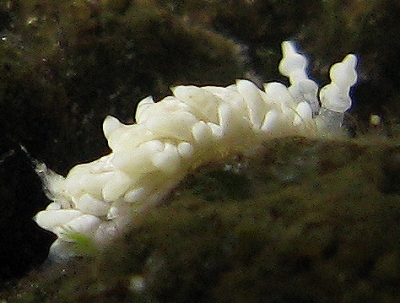
Concerning message #20650:
Dear Bill,
Here is another record of Aeolidiella alba from Reunion Island. We can see the red patch between rhinophores. It is the second specimen that I have seen in the same area.
Locality: Etang-Salé, 50 cm, Reunion Island, Indian Ocean, 11 May 2008, Night. Length: 12 mm. Photographer: Hugues Flodrops.
Best regard.
Hugues
hugues.flodrops@wanadoo.fr
Flodrops, H., 2008 (Jul 31) Aeolidiella alba from Reunion.. [Message in] Sea Slug Forum. Australian Museum, Sydney. Available from http://www.seaslugforum.net/find/21583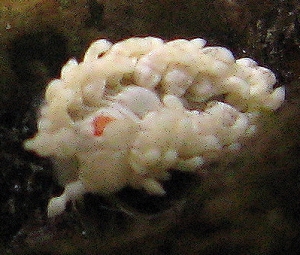
Dear Hugues,
Thanks for the record. It's strange how the red pigmentation changes and moves around the anterior end of the body. It is clearly not a geographic change as in your earlier specimen, and a specimen from nearby Tanzania [see Fact Sheet], the red pigmentation is restricted to a red ring around the base of the rhinophores.
Best wishes,
Bill Rudman
First record of Aeolidiella alba from Reunion Island
July 31, 2008
From: Hugues Flodrops
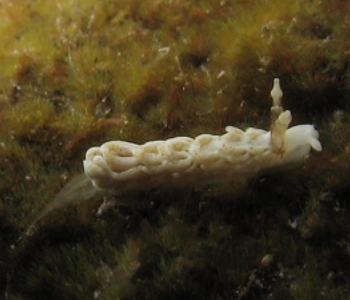
Concerning message #20555:
Dear Bill,
Here is probably Aeolidiella alba. It is the first observation of this species from Reunion Island. The red ring around the base of the rhinophores isn't clearly visible. But I confirm that this aeolid moved with a jerking or jumping movement. I look forward your input.
Locality: Etang-Salé Rocky Coast, 1 metre, Reunion Island, Indian Ocean, 4 September 2007. Length: 8-10 mm. Photographer: Hugues Flodrops.
Thanks again.
Regards.
Hugues.
hugues.flodrops@wanadoo.fr
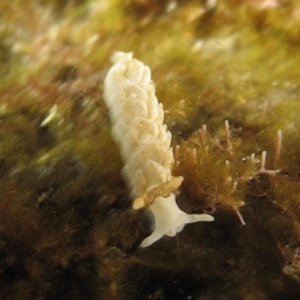
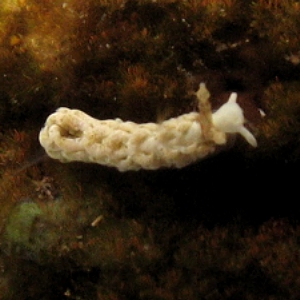
Dear Hugues,
This looks almost identical to the animal I have photographed from nearby Tanzania [see Fact Sheet]. The red pigmentation in this animal forms a narrow ring around the rhinophores rather than a big smudged patch, as seen in some specimens.
Best wishes,
Bill Rudman
New record from Brazil [1]
August 23, 2007
From: Vinicius Padula
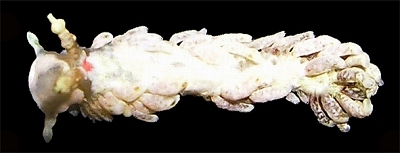
Dear Bill,
In our new paper [see #20244 ] there are new records of some species for Brazilian waters including Aeolidiella alba.
- Padula, V. and Santos, F. N. (2006) Three new records of Nudibranchia (Mollusca, Gastropoda) - Additions on the Brazilian Biodiversity. Biociencias, Porto Alegre,14: 214-220.
Best wishes,
Vinicius
viniciuspadula@yahoo.com
Padula, V., 2007 (Aug 23) New record from Brazil [1]. [Message in] Sea Slug Forum. Australian Museum, Sydney. Available from http://www.seaslugforum.net/find/20555Re: Aeolidiella alba from Florida, USA
March 9, 2007
From: Vinicius Padula
Concerning message #19598:
Dear Bill and Linda,
Edmunds & Just (1983) reported this species as "Spurilla alba " to Barbados based in a single specimen 7 mm long.
They also observed the movement of the rinophores as described by Alicia Hermosillo in the specimen from Mexico and now in this specimen from Florida. Concerning the wide distribution of this species, the authors commented on the possibility that it was introduced into the Atlantic by a ship or a boat.
-
Edmunds, M. & Just, H. (1983) Eolid nudibranchiate Mollusca from Barbados. Journal of Molluscan Studies, 49: 185-203.
Best wishes,
Vinicius Padula
viniciuspadula@yahoo.com
Padula, V., 2007 (Mar 9) Re: Aeolidiella alba from Florida, USA. [Message in] Sea Slug Forum. Australian Museum, Sydney. Available from http://www.seaslugforum.net/find/19627Thanks Vinicius,
Bill Rudman
Aeolidiella alba from Florida, USA
March 8, 2007
From: Linda Ianniello
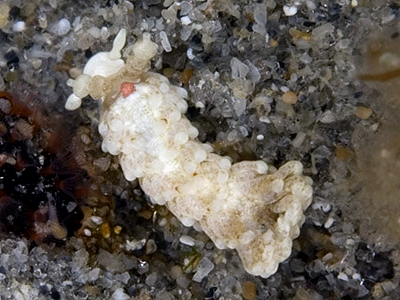
Dr. Bill,
I found this tiny slug yesterday. What attracted me was the unusual jerky movement of the rhinophores described by Alicia Hermosillo in her message [#6542 ]. It was so small I never would have realized it was a sea slug otherwise.
Dr. Angel Valdes made the identification.
Locality: Deerfield Beach, 9 feet, FL, USA, Atlantic, 03 March 2007, Ocean beach, sandy rubble. Length: less than 1/2 inch. Photographer: Linda Ianniello.
Linda Ianniello.
lindai1@bellsouth.net
Ianniello, L.M., 2007 (Mar 8) Aeolidiella alba from Florida, USA. [Message in] Sea Slug Forum. Australian Museum, Sydney. Available from http://www.seaslugforum.net/find/19598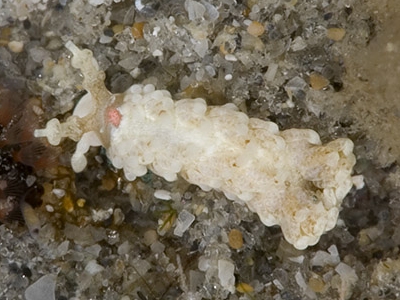
Dear Linda,
This is a very interesting find. As far as I know this is the first record of this species from the Caribbean, and for that matter, anywhere in the Atlantic. It joins a growing list of species now known from around the tropical waters of the world. I guess with such a small species like this we will never know whether the lack of earlier records of this species in the Caribbean is a result of it being a recent arrival, or because it has been overlooked by previous biologists. Ali Hermosillo's messages from Mexico, are also the first records of this species from the East Pacific.
It is also nice to know of someone else who has seen the strange way this species waves its cerata in rhythm. As I discuss in Ali's message, andother species which does something similar is Limenandra nodosa
Best wishes,
Bill Rudman
Aeolidiella alba from Northern New South Wales
February 7, 2005
From: Denis Riek
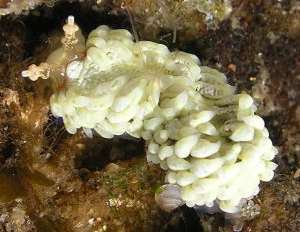
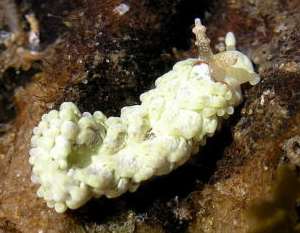
Dear Bill
Here are some shots of Aeolidiella alba from the Brunswick River. They were fairly common this year and were widely dispersed on rocks, sand and weed but always easy to see with their distinctive shuffle.
Locality: Brunswick River, nthn New South Wales, Australia. Depth: 2-4 metres. Length: 10mm. August-July 2004. On rocks, weed and sand. Photographer: Denis Riek
Regards,
Denis
denisriek@hotmail.com
Riek, D.W., 2005 (Feb 7) Aeolidiella alba from Northern New South Wales. [Message in] Sea Slug Forum. Australian Museum, Sydney. Available from http://www.seaslugforum.net/find/12924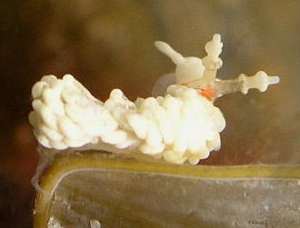
Dear Denis,
I am glad you can see the characteristic 'shuffle'. When I used to describe the way it 'walked' to people, rhythmically waving its cerata forward, I was surprised others hadn't noticed it. I guess unless you find it crawling along, or stop and watch it, you won't see it doing it. I particularly like your photo alongside. It shows the shape of the rhinophores very well.
Best wishes,
Bill Rudman
Aeolidiella alba from Lembeh Strait, Indonesia
March 18, 2004
From: Angeli Lok
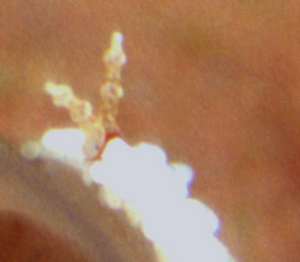
Can you specify the name of this species? It was found on sponge in Lembeh Strait, Indonesia, depth about 15m, water temperature 27 degree.
Angeli Lok
angelilok@hotmail.com
Lok, A., 2004 (Mar 18) Aeolidiella alba from Lembeh Strait, Indonesia. [Message in] Sea Slug Forum. Australian Museum, Sydney. Available from http://www.seaslugforum.net/find/12449Dear Angeli,
You are lucky that the only part of your photo that is not overexposed is the rhinophores. Their shape and the red ring around their base is found only in one species - Aeolidiella alba
Best wishes
Bill Rudman
Re: Aeolidiella alba from Mexico
April 1, 2002
From: Alicia Hermosillo
Dear Dr. Rudman,
Thanks for your advice. You are right, many things seem obvious and non-important while on the field and then you go back home and start wondering.
To Cory´s comment Cory´s comment I would say of what I have seen A. alba is that the way it moves makes it very conspicuous and I am having a hard time remembering another animal that resembles it in any way, I will keep looking though. Anyhow, I will keep you posted on anything and continue sending pictures and information. Right now I am in Yucatan, diving the Caves and Cenotes, quite a contrast.
Best regards
Alicia
gueri25@hotmail.com
Hermosillo, A., 2002 (Apr 1) Re: Aeolidiella alba from Mexico. [Message in] Sea Slug Forum. Australian Museum, Sydney. Available from http://www.seaslugforum.net/find/6648Re: Aeolidiella alba from Mexico
March 30, 2002
From: Cory Pittman
Dear Bill,
Re: the discussion about Aeolidiella alba and its movements. It is one of the more common diurnally active aeolids in Hawaii. In my experience, it almost always contracts its cerata rhythmically while crawling both in dishes and in the field. It's just speculation, of course, but I've always wondered if there might be an element of mimicry involved. At least to a human eye, its form, size, chalky-white coloration and rhythmic movement make it resemble a deteriorating sprig of Neomeris waving in the surge.
Best wishes,
Cory
Cory@cet.com
Pittman, C., 2002 (Mar 30) Re: Aeolidiella alba from Mexico. [Message in] Sea Slug Forum. Australian Museum, Sydney. Available from http://www.seaslugforum.net/find/6626Re: Aeolidiella alba in Mexico
March 28, 2002
From: Alicia Hermosillo
Dear Dr. Rudman,
I will try to shoot some video next time I come across a Aeolidiella alba. Anything else I should check on?
Best regards
Alicia
gueri25@hotmail.com
Hermosillo, A., 2002 (Mar 28) Re: Aeolidiella alba in Mexico. [Message in] Sea Slug Forum. Australian Museum, Sydney. Available from http://www.seaslugforum.net/find/6578Dear Ali,
I guess it would be nice to know if the cerata move in Mexican animals the same way as I have described for Australian animals.
What else should you check on? If you are asking about your whole survey work at Bahia de Banderas, not just about Aeolidiella alba, I would suggest you make a note of anything that is interesting about living animals you come across. If they wave their mantle, is it all the mantle, or just the anterior end etc, etc. Do they wave their gills? If so is it a regular fast flicker, or a slow irregular movement? These things may not seem important at the time, but in a few months or years you may be looking for a character to sort two species which are very similar in colour or anatomy, and such a character may become extremely important.
The other thing you can't do with preserved animals is learn about their egg ribbons development type or food. So my advice would be to try and incorporate this into your survey work. When you collect specimens, try and collect a sample of their food. Getting food items identified is often difficult, as there are few competent experts in the world in most marine invertebrate groups. So to make your food sample appealing to an overworked expert, take a good photo of it so the expert gets a specimen and a photo for their records. From my experience, being able to show a sponge or soft-coral expert a photo, usually makes your request for an identification much more interesting to them than just a preserved decolourised specimen. It is also useful, if possible, to keep animals you are collecting alive for a while, even overnight, in the chance they will lay an egg ribbon, which you can photograph.
In brief, make notes about your animals, don't rely on your memory, and even if you are taking good photos, make a quick sketch and note the basic colour pattern. In a year or two you may discover when you dissect one of your 'species' that there are two quite different species with almost identical colour patterns. Unless you have good colour notes of your earlier collections, the only way you will be able to separate them is to dissect them all, and you really don't want to have to do that. And finally, the first time you find a species may be the last time you see it, so never say to yourself I'll take a photo and draw this one next time I find it.
These of course are impossible standards. We all regret the one we should have photographed but were too tired, or hungry etc.
Good Luck,
Bill Rudman
Aeolidiella alba from Mexico
March 27, 2002
From: Alicia Hermosillo
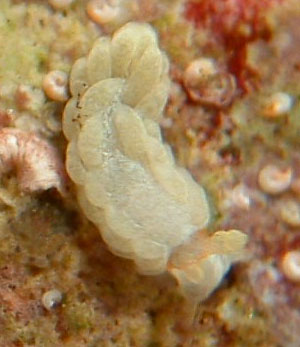
Dear Bill,
This specimen Aeolidiella alba is from Playa Mismaloya, Bahia de Banderas, states of Jalisco and Nayarit, Mexico [Pacific Coast]. Depth: 52 feet, Length: 5 mm. I have seen it under and on top of rocks.
In order to identify the first A. alba that I saw (and did not photograph then), I described it to taxonomist Dr. Sandra Millen as: "a little white spurilla like aeolid that moved in the funkiest kind of way, swaying the rinophores back and forth, kind of jumping instead of sliding smoothly". Sandra answered me in no time. Has any of you seen this? It is awesome.
Alicia
gueri25@hotmail.com
Hermosillo, A., 2002 (Mar 27) Aeolidiella alba from Mexico. [Message in] Sea Slug Forum. Australian Museum, Sydney. Available from http://www.seaslugforum.net/find/6542Dear Alicia,
I am interested in your description if it moving. I have notes of an animal I found in Coffs Harbour, New South Wales in eastern Australia some time ago. It was about 6mm long and had 7 rows of cerata. The cerata in the front 4 rows lay flat against the body, but the cerata in the posterior 3 rows stood upright. As the animal crawled along the upright cerata at the back, and the rhinophores, all jerked backwards and forwards in a rhythmic motion.
I have reported another aeolidiid, Limenandra nodosa, with a similar jerking movement. In that case it is the innermost ceras in each second row that jerk. In both animals it gives the appearance of the animal jerking along - or jumping - as you describe it. Interestingly, in your photo, the front 3 rows of cerata seem to be lying down, and the back 3 standing up, much as I described.
Like you, I would be interested in any other observations of this motion. Has anyone else seen this?
best wishes,
Bill Rudman
Aeolidiella alba? from South Africa
December 17, 2001
From: Valda Fraser

Dear Bill
My best bet is Aeolidiella alba. I look forward to your input.
Thanks.
Locality: Pumula, south coast KwaZulu-Natal, South Africa, intertidal zone
Date: December 2001
Size: 12 mm
Regards
Valda Fraser
valdafraser@mweb.co.za
Fraser, V., 2001 (Dec 17) Aeolidiella alba? from South Africa. [Message in] Sea Slug Forum. Australian Museum, Sydney. Available from http://www.seaslugforum.net/find/5840Dear Valda,
I agree with your bet. Although there is no sign of the red ring around the base of the rhinophores, the shape of the rhinophores and cerata arrangement are typical of this species.
Best wishes,
Bill Rudman
Aeolidiella alba from Sulawesi
July 20, 2000
From: Lindsay Warren
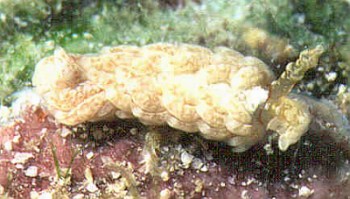

Dear Bill
I found this 5mm long specimen which I think is Aeolidiella alba at 11:00 on 3 August 1999 at a depth of 19 ft on a deep water mooring line covered in algae and small hydroids at one of the dive sites on Pulau Hoga, Tukang Besi Archipelago, SE Sulawesi, Indonesia. [Operation Wallacea]
In one shot the cerata are relaxed on the notum whereas in the other they are shown flared when disturbed. On the notum behind the rhinophores is a medium sized black spot (unfortunately not visible in the photos).
Immediately behind the rhinophores is an orange line. The rhinophores are mottled and annulate. The cerata are pale pinky brown rather than white which, I presume, the name 'alba' implies. Photos: Lindsay Warren.
Looking forward to your thoughts as ever.
All the best
Lindsay Warren
alldcl@compuserve.com
Warren, L., 2000 (Jul 20) Aeolidiella alba from Sulawesi. [Message in] Sea Slug Forum. Australian Museum, Sydney. Available from http://www.seaslugforum.net/find/2739
Dear Lindsay,
I must say I have never seen such an agitated Aeolidiella alba as the ones in your photo. I have always found it to be a rather sedate thing showing little sign of movement with its cerata neatly arranged and lying flat on its back.
Despite that, I am sure your animal is the same. The distinctive features are the the swollen sections on the rhinophores and the red line around the base of the rhinophores which sometimes forms a complete ring, and other times just a line behind them, as in your specimen.
I am afraid I had some better photos from Tanzania of the typical white form, which gives the species its name, but I am afraid they succumbed to fungus. I have attached the only photo I have which was photographed by chance in a dish and looks like a hydroid stalk has fallen on it. It does however show the typical white cerata, red ring and golden coloured rhinophores. [Photo: North Reef (on sewer pipe), Dar es Salaam, Tanzania. May 1974].
Best wishes,
Bill Rudman.
